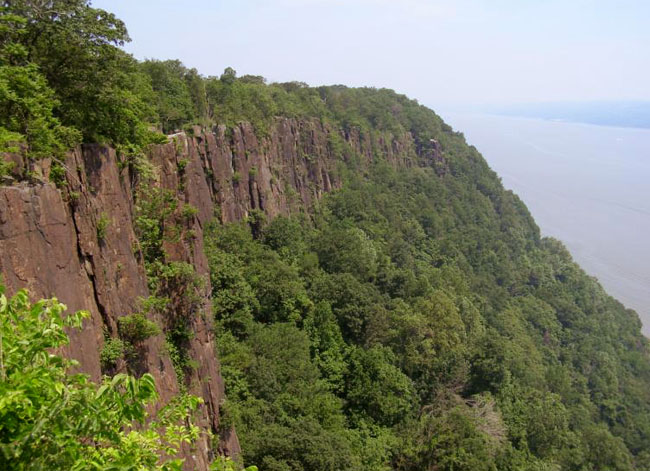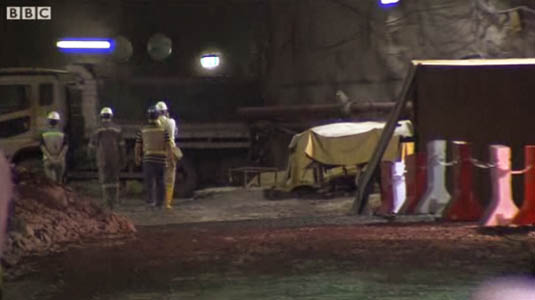Recently, I’ve been looking back at a collaborative project with John Becker of WROT Studio.
The “Institute for Controlled Speleogenesis” (2014) was a fictional design project we originally set in the vast limestone province of Australia’s Nullarbor Plain.
 [Image: A rock-acid drip-irrigation hub for the “Institute for Controlled Speleogenesis,” a collaboration between BLDGBLOG and WROT Studio; all images in this post are by John Becker of WROT Studio.]
[Image: A rock-acid drip-irrigation hub for the “Institute for Controlled Speleogenesis,” a collaboration between BLDGBLOG and WROT Studio; all images in this post are by John Becker of WROT Studio.]
The Nullarbor Plain is a nearly treeless region, roughly the size of Nebraska. It is also the world’s largest karst landscape, and thus home to hundreds of natural caves.
“There is a great variety of cave types under the Nullarbor,” as Australian Geographic explains, “but the plain’s most interesting features are long, deep systems (such the Old Homestead Cave), which are found only here, in the U.S. state of Florida, and on Mexico’s Yucatan Peninsula, all of which all have similar karst limestone layers.”

The Institute for Controlled Speleogenesis was imagined as a remote, thinly staffed site for applied geological research, where huge artificial caves could be generated below the Earth’s surface using a special acid mix—as safe as vinegar, but, importantly for our project, capable of dissolving limestone on a greatly accelerated timescale.

Subterranean spaces of every conceivable size, from tiny hollows and capillaries to vast megastructures, could thus be acid-etched into even the deepest karst formations, both rapidly and over decadal expanses of time.

The resulting rooms, tunnels, and interconnected cave systems could be used for a wide range of purposes: generating speleo-pharmaceuticals, for example, as well as testing recreational caving equipment, experimenting with underground agricultural systems, or developing new technologies for subterranean navigation, communication, inhabitation, and mapping.

As John writes on his own website—where you can also see larger, more-detailed versions of these images—our “aberrant caverns,” in John’s phrase, would be monitored in real-time by autonomous systems operating 24 hours a day.
The ever-growing caves could thus be left on their own, unsupervised, while the acid-drip system gradually etches down, drop by drop, reaching increasingly remote underground realms that the acid itself creates.

As a preliminary step, different blends of rock-acid mix would first be tested on large pillars aboveground, to choose or highlight specific spatial effects.


Controlled showers of rock-acid would result in totem-like sculptures, like industrial-scale menhirs—Stone Age ritual artifacts by way of 21st-century geochemistry.

Once the desired effects have been achieved, fields of bladders, nozzles, and injection arrays can be programmed and choreographed to enlarge an artificial cave mouth.

The irrigation system can then be continued underground. Necklaces of acid-drip arrays can easily be extended underground in order to expand the cave itself, but also to lengthen certain tunnels or to experiment with architecturally stable cave formations.


As John explains, the images seen here depict an “injection array using a pressurized system to move large quantities of solution to underlying areas of the cave network. These injection sites are outwardly the tell for a hidden world below. Much like oil derricks extracting resources from the earth, their density and scale across the landscape give you a glimpse into areas afforded the most resources for injection.”

Our initial siting of this in the Nullarbor Plain was motivated entirely by geology, but other large limestone provinces—from Kentucky or northern Arizona to southern France, and from California’s Lucerne Valley to Egypt—would also be good hosts.
While we looked into standard mining acids, currently used for stripping tailings piles of valuable minerals, it quickly became apparent that specific kinds of acetic acid—again, no more toxic than vinegar—offered a more viable approach for creating a maximally spacious site with minimally polluting environmental implications. (Of course, should someone without such qualms want to explore this set-up with no concern for its ecological impact, then much stronger acids capable of dissolving much stronger rocks could also be explored.)

In 2022, I was excited to see that John returned to this project, generating a new series of images using AI image-generation software trained on our earlier project documentation. Given their provenance, the resulting images are unsurprisingly cinematic—equal parts cyberpunk dereliction and underworldly luminescence.




Over the years, John has become a wizard at producing Modernist geological imagery, publishing images on his Instagram account—rock sculpted as smooth as paper and as diaphanous as a veil or curtain.
Check out his own website for more images of the Institute for Controlled Speleogenesis and other recent projects. And, if you like this, don’t miss “Architecture-by-Bee and Other Animal Printheads,” an earlier project of ours that I’m proud to say was published in Paul Dobraszczyk’s excellent recent book, Animal Architecture: Beasts, Buildings and Us.
(All images in this post are by John Becker of WROT Studio. This post contains a Bookshop.org affiliate link, meaning that I might receive a small percentage of any resulting sales.)
 [Image: Photo by
[Image: Photo by 





 [Image: A salt cave in Israel; image via
[Image: A salt cave in Israel; image via 















 [Image: “Caves for New York” (1942) by Hugh Ferriss].
[Image: “Caves for New York” (1942) by Hugh Ferriss]. [Image: The
[Image: The 

 [Image: From the
[Image: From the  [Image: From the
[Image: From the  [Image: From the
[Image: From the  [Images: From the
[Images: From the  [Image: From the
[Image: From the 
 [Image: Singapore expands beneath the Pacific Ocean; via the
[Image: Singapore expands beneath the Pacific Ocean; via the 
 [Images: Singapore expands beneath the Pacific Ocean; via the
[Images: Singapore expands beneath the Pacific Ocean; via the